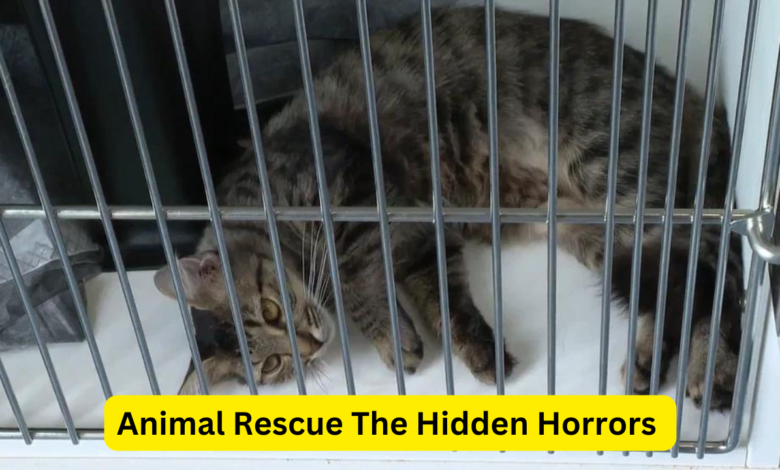Animal Rescue

Animal rescue is often viewed as a noble and compassionate mission. Dedicated individuals and organizations commit themselves to saving animals from abuse, neglect, and abandonment. However, beneath the surface of this seemingly altruistic effort lies a darker, more insidious issue—animal hoarding. This disturbing phenomenon occurs when individuals, often self-proclaimed rescuers, accumulate more animals than they can adequately care for, leading to horrific conditions of neglect and suffering. The very act of rescuing, which is intended to save animals, becomes the cause of their torment.
The Disturbing Case of the “Crazy Rescue Ladies”
One of the most shocking instances of animal hoarding in recent history involved a group of women infamously known as the “Crazy Rescue Ladies.” These women, who initially portrayed themselves as passionate animal lovers, were found hoarding hundreds of animals in unsanitary, overcrowded conditions. The discovery of this case sent waves of shock and outrage across the nation. Crates of animals were stacked on top of each other, with little to no regard for the health and safety of the creatures trapped inside. Many of these animals were found in critical condition, suffering from malnutrition, untreated medical issues, and severe psychological stress.
This case, although extreme, is not an isolated incident. It represents a broader and deeply troubling issue within the animal rescue community, where the line between rescue and hoarding becomes dangerously blurred. The well-intentioned efforts to save animals spiral out of control, resulting in catastrophic consequences for the animals involved.
The Psychological Aspects of Animal Hoarding
To fully understand animal hoarding, it is essential to delve into the psychological factors that drive this behavior. Many hoarders suffer from underlying mental health disorders, such as obsessive-compulsive disorder (OCD), anxiety, and depression. These individuals often develop an intense emotional attachment to animals, viewing them as a source of comfort and stability. However, this attachment can become unhealthy, leading to the accumulation of more animals than they can properly care for.
Hoarders may start with genuine intentions, believing they are helping animals in need. However, as the number of animals increases, they quickly become overwhelmed by the responsibilities of providing adequate food, shelter, and medical care. The situation deteriorates rapidly, with animals living in filthy, overcrowded environments that pose severe health risks to both the animals and the hoarder.
The Legal and Ethical Implications of Animal Hoarding
Animal hoarding is not just a personal issue—it has significant legal and ethical implications. In many cases, the conditions in which animals are kept violate local and state animal welfare laws. Hoarders may face criminal charges for animal cruelty, neglect, and violating zoning regulations. The legal system often struggles to address these cases effectively, as hoarders may be deeply resistant to parting with their animals, even when faced with legal consequences.
From an ethical standpoint, animal hoarding raises critical questions about the responsibility of individuals and organizations involved in animal rescue. It underscores the need for stricter regulations and oversight to prevent such situations from occurring. Animal welfare organizations must work closely with mental health professionals, law enforcement, and the community to identify and address potential hoarding cases before they escalate into full-blown crises.
The Role of Animal Welfare Organizations in Preventing Hoarding
Preventing animal hoarding requires a proactive and multi-faceted approach from animal welfare organizations. These organizations play a crucial role in educating the public about the signs of hoarding and the importance of responsible animal care. They must also remain vigilant in monitoring rescue groups and individuals who may be at risk of developing hoarding behaviors.
Collaboration with mental health professionals is essential in addressing the underlying psychological issues that contribute to hoarding. By providing mental health support to individuals at risk, animal welfare organizations can help prevent the accumulation of animals and the subsequent neglect that often follows.
Additionally, community involvement is vital in identifying and reporting potential hoarding situations. Neighbors, friends, and family members who suspect someone of hoarding animals should not hesitate to report their concerns to local authorities or animal welfare organizations. Early intervention can make a significant difference in preventing the suffering of both the hoarder and the animals involved.
The Consequences of Inaction
Failing to address animal hoarding can have devastating consequences for both animals and humans. The animals involved endure immense suffering, often experiencing prolonged periods of neglect and abuse. Many of these animals develop serious medical conditions that go untreated, leading to unnecessary suffering and, in some cases, death.
For the hoarders themselves, the situation can lead to social isolation, financial ruin, and deteriorating mental health. The living conditions in hoarding situations are often hazardous, with accumulated waste, high levels of ammonia from urine, and the spread of diseases posing significant health risks to the hoarder and anyone living in or near the property.
The broader community is also affected by hoarding. The costs associated with rescuing and rehabilitating animals from hoarding situations can be substantial, placing a financial burden on local animal shelters and rescue organizations. Moreover, the legal and social services required to address these cases strain public resources.
Taking Action: What Can Be Done?
Addressing the issue of animal hoarding requires a comprehensive, multi-disciplinary approach involving animal welfare organizations, mental health professionals, law enforcement, and the community. Here are some key steps that can be taken to combat animal hoarding:
Public Education
Raising awareness about the signs of animal hoarding and the importance of responsible pet ownership is crucial. Educational campaigns can help prevent hoarding by informing the public about the dangers of taking on more animals than one can care for.
Mental Health Support
Providing mental health services to individuals at risk of hoarding can prevent the escalation of the problem. Counseling, therapy, and support groups can help address the underlying psychological issues that contribute to hoarding behavior.
Stronger Legislation and Enforcement
Advocating for stricter animal welfare laws and ensuring their enforcement is essential in preventing and addressing hoarding cases. Lawmakers should consider creating specific legislation that addresses the unique challenges posed by animal hoarding.
Community Involvement
Encouraging the community to be vigilant and report suspected hoarding cases can lead to earlier intervention. Neighbors, friends, and family members can play a vital role in identifying and stopping hoarding before it becomes a crisis.
Support for Rescued Animals
Animal shelters and rescue organizations need adequate resources to care for animals rescued from hoarding situations. This includes medical care, rehabilitation, and finding new homes for the animals.
Conclusion
Animal hoarding is a complex and tragic issue that requires a comprehensive approach to address effectively. By understanding the psychological, legal, and ethical aspects of hoarding, and by taking proactive steps to prevent and address it, we can help protect the well-being of both animals and the individuals who care for them.




One Comment